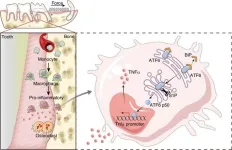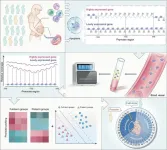(Press-News.org) UC Santa Cruz Assistant Professor of Environmental Studies Scott Winton has been wading through thick, smelly muck in the tropics for almost a decade. He wouldn’t have it any other way. As a wetland ecologist and biogeochemist, he’s been hard at work investigating an important and mysterious topic: peatlands.
Peatlands are a special type of wetland with enormous potential to either help or hurt global efforts to address climate change. If we want peatlands on our side, we’ll have to protect them. But that’s difficult to do, since we still don’t yet know how many of them exist or where they are.
Winton’s latest research, published in the journal Environmental Research Letters provides the first data-driven map of both newly documented and predicted peatland areas across Colombia’s eastern lowlands. Institutions including ETH Zurich, Pontificia Universidad Javeriana, and Stanford University contributed to the research. Winton is lead author, and senior author Alison Hoyt is an Assistant Professor of Earth System Science at Stanford.
Winton and the team estimate that the region contains somewhere between 7,370 and 36,200 square kilometers of peatlands. Protecting these ecosystems could help Colombia reduce its carbon emissions as part of international climate change agreements.
Carbon emissions are the excessive amounts of carbon dioxide gas released into the atmosphere by human activities, especially the burning of fossil fuels like coal, oil, and natural gas. When excess carbon dioxide builds up in the atmosphere, it acts like a heat trapping blanket, warming our planet and resulting in climate change. To address the problem, we mainly need to reduce our use of fossil fuels. But it’s also important to conserve key ecosystems that naturally act as “carbon sinks,” trapping and storing some of our emissions underground.
That’s where peatlands come in. Peatlands are great at capturing carbon because their perpetually soggy soils deprive decomposer organisms of the oxygen they need to fully break down dead plants. Normally, plants absorb some carbon dioxide from the atmosphere and incorporate the carbon into their tissues, then when the plants die, decomposers digest them, releasing carbon dioxide back into the atmosphere. But in peatlands, the decomposition process grinds to a halt, so over time, a large amount of carbon accumulates and remains trapped in peat soils in the form of partially decomposed organic matter.
In Colombia, Winton’s team found that the average per-area carbon densities in peatlands are four to 10 times higher than in the Amazon rainforest. This finding tracks with what scientists know about the carbon sequestration abilities of peatlands in other parts of the world.
“On a global scale, peatlands cover only 3% of land surface but store more carbon than all of the world’s trees,” Winton explained. “We tend to focus on trees when we think about natural capacity to remove some of the excess carbon dioxide from our atmosphere, but peatlands punch way above their weight in terms of carbon storage.”
Essentially, peatlands are like unsung heroes that have been working behind the scenes to help buffer the impact of our fossil fuel emissions. But there’s a catch. Peatlands can only continue to store carbon if they remain consistently wet. When peatlands are drained for agriculture or other development, decomposer organisms in the soil get right back to work breaking down the partially decomposed organic matter in peat soils, releasing stored carbon into the atmosphere. Dried out peatlands can also catch fire, rapidly releasing their carbon stores.
Unfortunately, this scenario is currently playing out in some parts of the world.
“There has recently been mass drainage of peatlands for agriculture in Southeast Asia, resulting in soil compaction and subsidence and catastrophic wildfires that become a huge source of carbon to the atmosphere,” Winton said. “Indonesia, for example, is actually a huge outlier in terms of their emissions relative to GDP because of these types of land conversion. And once peatlands are destroyed, they can take 1,000 years to recover lost soil carbon, so it really demonstrates the importance of working proactively to protect these ecosystems.”
One of the major challenges in protecting peatlands is that they’re not always easily distinguishable from other types of wetlands based on their surface appearances. Documenting them requires careful investigation, but they remain understudied in many parts of the world. In Colombia, for example, five decades of civil war previously made many parts of the country inaccessible for ecological research. Peace agreements have now made research possible, but the country is also experiencing rapid environmental degradation, meaning there’s a good chance that peatlands are being destroyed before they can even be identified.
Finding Colombia’s peatlands and slowing the rate of their destruction could prevent the release of significant carbon stores, reducing the nation’s overall carbon emissions. With that goal in mind, Winton and a team of researchers set out in search of peat. Starting in regions identified by a global predictive map for wetlands, they talked with local people to get a sense for what plant communities might be associated with peatlands. Then they used satellite imagery to find promising areas to visit and investigate. It was a difficult, but ultimately rewarding process that spanned three years.
“We visited a lot of wetlands without finding any peat, and we kind of had to stumble around and struggle a bit before we figured out how to find what we were looking for,” Winton recalls. “One day we were swimming through chest-deep water in this swamp, and I remember diving down under the flood water to grab a handful of soil. That’s when we found our first peat, and we realized we were finally in the right place.”
Winton and his team ended up finding peat soils at 51 of the more than 100 wetland sites they visited. At each site where they found peat, they collected soil samples and detailed data on water conditions and plant communities. They identified two specific types of Colombian peatlands—palm swamps, and white-sand peatlands—both with forested and open variations. White-sand peatlands had not previously been documented in South America. Winton’s team described them as permanently wet areas forested by thin-stemmed and often stunted trees, growing in up to two meters of peat soil atop white sand.
The team’s new observations about the characteristics of Colombia’s peatlands allowed them to build an improved predictive model, showing where additional peatlands likely exist across Colombia’s lowlands. Researchers also analyzed the soil samples they collected in order to determine their carbon content. Taken together, these results allowed the team to estimate that Colombia’s peatlands may currently be sequestering an amount of carbon equivalent to 70 years worth of the country’s emissions from fossil fuels and industry.
Winton hopes that improved understanding of the value of these peatland resources and where they might be distributed could help local scientists and the Colombian government continue the work to identify and protect more of the country’s peatlands.
“There are many places across Colombia and around the world where we could still find large peatlands that we didn’t know existed that would totally upend current assumptions,” Winton said. “We really need more research across the tropics to groundtruth and identify the distribution of peatlands, so that we can prioritize their conservation globally with a more complete picture.”
END
Colombia’s peatlands could be a crucial tool to fight climate change. But first we have to find them
2025-04-15
ELSE PRESS RELEASES FROM THIS DATE:
Researchers refine a hybrid music therapy intervention for patients with cardiac and pulmonary conditions
2025-04-15
CLEVELAND – A new study from University Hospitals Connor Whole Health found that it was feasible to conduct a hybrid music therapy intervention for patients with heart failure and patients with chronic obstructive pulmonary disease (COPD). Participants reported positive effects on their mental health, and the pilot uncovered solutions to improve future research with this population. The findings from this study were recently published in BMC Complementary Medicine and Therapies.
Patients with chronic illnesses such as heart failure and COPD face significant challenges due ...
Research Spotlight: Combining dexmedetomidine with spinal anesthesia prolongs pain relief and decreases shivering during surgery
2025-04-15
Heitor Medeiros, MD, and A. Sassan Sabouri, MD, of the Department of Anesthesia, Critical Care and Pain Medicine at Massachusetts General Hospital, are the lead and corresponding authors, respectively, of a paper published in the British Journal of Anaesthesia (BJA).
How would you summarize your study?
Spinal anesthesia is widely used to numb patients during surgery, but its effects sometimes wear off too soon. Many anesthetists have experimented with adding extra drugs to extend pain relief. Dexmedetomidine demonstrated results in multiple randomized clinical trials suggesting it could prolong numbness ...
Pennington Biomedical’s 2025 Bray Obesity Symposium to offer on-demand continuing education for physicians
2025-04-15
FOR IMMEDIATE RELEASE
April 15, 2025
BATON ROUGE – The 2025 Bray Obesity Symposium welcomes all health physicians and researchers interested in the latest in metabolic health to register for the on-demand online offerings. The online-only content is available to access upon registration, and the symposium has been designated by the American Board of Obesity Medicine, or ABOM, as a Group One Primary Medicine Continuing Medical Education partner.
The symposium is an intensive Board Review Course in preparation for the ABOM’s certification exam, including materials ...
Unlocking faster orthodontic treatments: the role of atf6 in bone remodeling
2025-04-15
Orthodontic treatments often take years, but a breakthrough discovery could drastically shorten this period. Researchers have uncovered that ATF6, a protein activated in macrophages during corticotomy, accelerates tooth movement by promoting inflammation and boosting the production of TNFα, a key factor in bone remodeling. This finding paves the way for faster, more efficient orthodontic procedures, minimizing both treatment time and patient discomfort. The study highlights the potential for non-invasive therapies that could reshape the future of orthodontic care.
Corticotomy, a surgical procedure aimed at accelerating tooth movement, ...
SwRI-led Lucy mission survey of main belt asteroid Donaldjohanson imminent
2025-04-15
SAN ANTONIO — April 15, 2025 —The Southwest Research Institute-led Lucy mission is preparing to survey the next target in its epic 4-billion-mile, 12-year, 11-asteroid tour. On April 20, 2025, NASA’s Lucy spacecraft will fly past the three-mile-wide main belt asteroid (52246) Donaldjohanson as a test run to the main event: visiting the never-before-explored Trojan asteroids in the Jupiter system.
For billions of years, these mysterious space rocks have been gravitationally trapped in two swarms leading and trailing Jupiter in orbit around the Sun, holding clues to the formation of our solar system. NASA’s Lucy spacecraft will be the ...
New bat cell lines and reagents help to study bat antiviral immune responses against hantaviruses and coronaviruses
2025-04-15
New bat cell lines and reagents help to study bat antiviral immune responses against hantaviruses and coronaviruses
In your coverage, please use this URL to provide access to the freely available paper in PLOS Biology: https://plos.io/3E5BYAJ
Article title: Expanding the bat toolbox: Carollia perspicillata bat cell lines and reagents enable the characterization of viral susceptibility and innate immune responses
Author countries: Canada, United States
Funding: see manuscript END ...
Preterm birth might be predicted with high accuracy with new cheap, non-invasive test, based on cell-free DNA collected in standard early pregnancy testing
2025-04-15
In your coverage, please use this URL to provide access to the freely available paper in PLOS Medicine: https://plos.io/3RuCJ9v
Article title: Genome-wide nucleosome footprints of plasma cfDNA predict preterm birth: A case-control study
Author countries: China, United Kingdom
Funding: This work was supported by project grants from the National Natural Science Foundation of China [81600404 to JT, 82270600 to JT, 81871177 to FY, 82271711 to XY, 82173001 to ZG]; Guangdong Basic and Applied Basic Research Foundation [2022A1515220204 to JT; 2024A1515012792 to ZG]; Guangzhou Key Laboratory ...
CVD researcher/clinician named editor-in-chief of Circulation: Genomic and Precision Medicine.
2025-04-15
DALLAS, April 15, 2025 — Ferhaan Ahmad, M.D., Ph.D., FAHA, is the new editor-in-chief of Circulation: Genomic and Precision Medicine, a peer-reviewed scientific journal published by the American Heart Association, effective with the journal’s April issue, published today. Ahmad is the founding director of the Cardiovascular Genomics Program and associate professor of internal medicine-cardiovascular medicine at the University of Iowa Carver College of Medicine in Iowa City, Iowa. He takes the helm leading Circulation: Genomic and Precision Medicine from Kiran Musunuru, M.D., Ph.D., M.P.H, FAHA, who served as interim editor-in-chief ...
Holy shift: More Americans finding faith outside church
2025-04-15
ITHACA, N.Y. – A "remarkable" transformation is underway in American religious life, new Cornell-led research finds: Large numbers are leaving organized religion – not in favor of secular rationality, but to pursue spirituality in ways that better align with their individual values.
This reimagining of religion outside traditional institutions fits within broader social changes that have prioritized individual fulfilment and “finding” oneself, including shifting views about gender and sexuality and the rise of the internet. Spanning political views, it also reflects a revolt against ...
New analysis underscores health risks of e-cigarettes
2025-04-15
A Johns Hopkins Medicine-led analysis of medical information gathered on a diverse group of almost 250,000 people over four years has significantly clarified the link between the “exclusive” use of e-cigarettes and chronic obstructive pulmonary disease (COPD), as well as high blood pressure in a sub-group of adults 30 to 70 years of age.
The findings, supported by funding from the National Institutes of Health and published in the March. 15 edition of Nicotine & Tobacco Research, underscore the potential risks of e-cigarette ...




